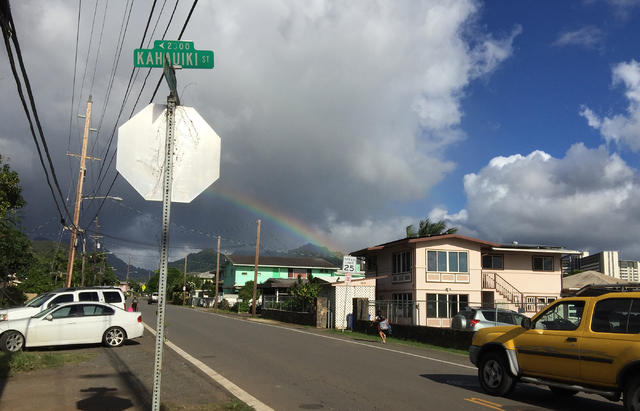Among the top neighborhoods for college graduates in the latest Census Bureau American Community Survey is a small, working-class neighborhood in Kalihi with no sidewalks.
Kahauiki Street, near Fern Elementary School and a few blocks from Kuhio Park Terrace, is listed as having 70 percent of its residents ages 25 and older with bachelor’s degrees.
The American Community Survey uses responses from about 10 percent of the state’s residents over five years to extrapolate the characteristics of the nation’s neighborhoods. As is the case for all surveys, there is a margin of error.
In small parts of the neighborhood like Kahauiki Street, the margin of error is higher (about 15 percent) than in larger areas like Waialae Iki or East Manoa (about 5 percent).
Some people who live on and around Kahauiki Street acknowledge that the American Community Survey ranking may actually be the result of a statistical error and there may not be as many college graduates in their neighborhood as in the more affluent ones.
But that doesn’t mean they aren’t smart or educated.
“My granddaughter has a master’s (in business),” said Kuulei Nobriga, who has been in the neighborhood and raised her kids in the same rental house for 42 years.
Her son Francis, a retired police officer, said a lot of women in nursing scrubs live in the area. They may be college graduates, he speculated.
Kahauiki Street’s residents are a mix of longtime and new residents, with many immigrants, Nobriga said.
The neighborhood consists of mostly older, wooden, single-story homes with some large multifamily homes and a few homes with dirt driveways.
SMART CITIZENS
>> For more information on the American Community Survey go to: census.gov/programssurveys/acs/data.html Opens in a new tab
>> For an analysis of Hawaii data go to: census.hawaii.gov/acs/acs-2014/ Opens in a new tab
Stephanie Wong, whose great-grandfather developed the neighborhood, said two of her five siblings graduated from college and all of her cousins, who grew up down the street, graduated from college.
At a park next to Fern Elementary School, Dylan Vaoang, who is in the fourth grade, did his homework as his sister kept busy on playground equipment.
His mother, Julie Vinluan, who attended nursing school but didn’t graduate, said Vaoang got a medal in math recently and hopes to go to college when he finishes high school.
The American Community Survey and the Hawaii State Data Center released the data from five years’ worth of surveys between 2010 and 2014.
Where do the smartest people in Hawaii live? How about those who make the most money, or speak foreign languages?
Here are some of the highlights:
>> Smartest people (population with a bachelor’s degree or higher)
The Hawaii neighborhoods with the highest percentage of people with a college education are all on Oahu.
In order, they are the Schofield Forest Reserve, where it’s suggested that all of the estimated 91 people who live there have a college degree; Waialae Iki (75.4 percent); Portlock (73.8 percent); East Manoa (71.6 percent) and Kahauiki Street in Kalihi, (estimated population 1,074) where the survey suggests 70 percent have a bachelor’s degree or higher.
On a side note, if you want to find the greatest concentration of people with at least a high school degree, go to military bases on Oahu, where in most neighborhoods 100 percent of the adults have graduated from high school.
>> Richest neighborhoods (highest median income)
No surprises here, unless you are really snobby and think your neighborhood should be ranked higher.
The neighborhoods with the richest residents are: Round Top Drive-Tantalus ($183,958), Waialae Iki ($173,864), Portlock ($145,250), Judd Hillside-Lowrey Avenue ($144,219), Maunawili ($140,038) and Ko Olina Resort ($139,167).
The areas with the highest income are also among the areas with the highest median value of homes. The median price of an owner-occupied home in the above neighborhoods, except for Maunawili and Ko Olina, tops $1 million.
>> People who speak a language other than English
If you want to hear people speaking other languages, the census data suggest you go to Mayor Wright Housing (68.4 percent), Linapuni Street (68.3 percent), Umi Street (68.2 percent) and Chinatown (66.2 percent). Hanauma Bay, with an estimated population of two, is actually ranked highest. But that census-designated neighborhood may be too small to really be part of the ranking.

